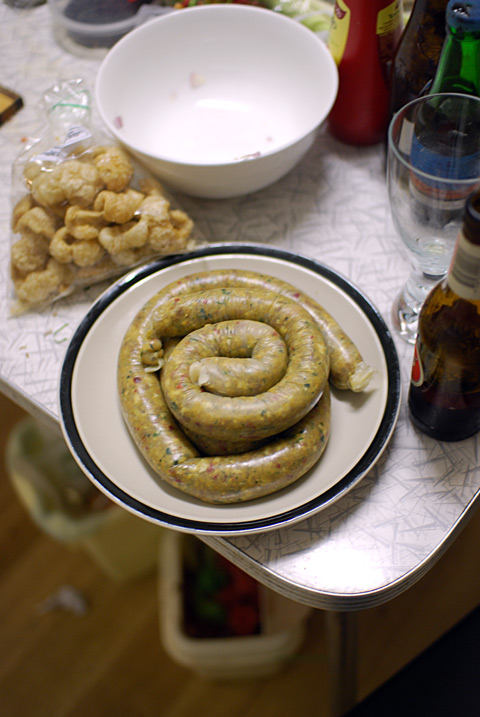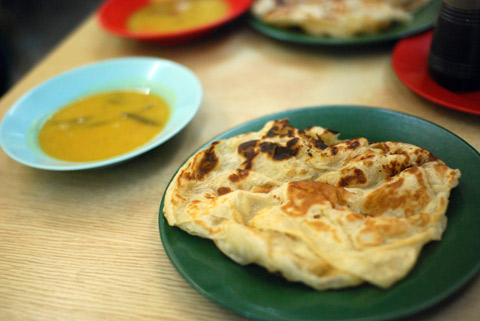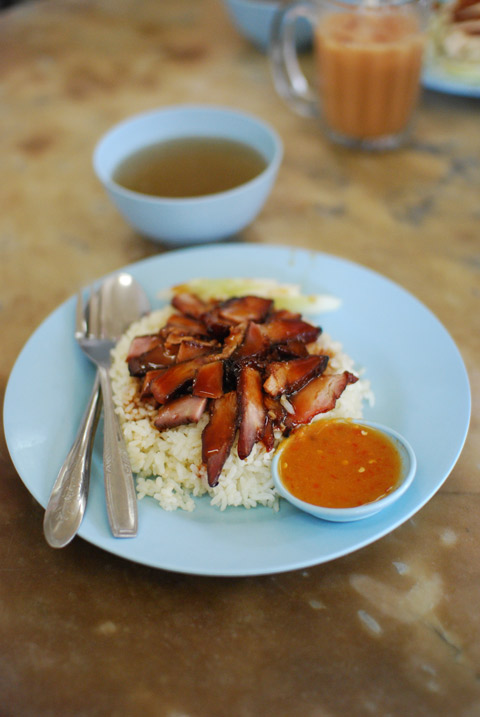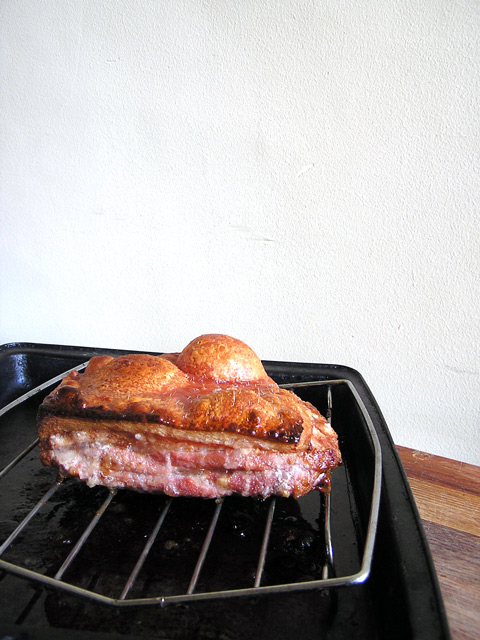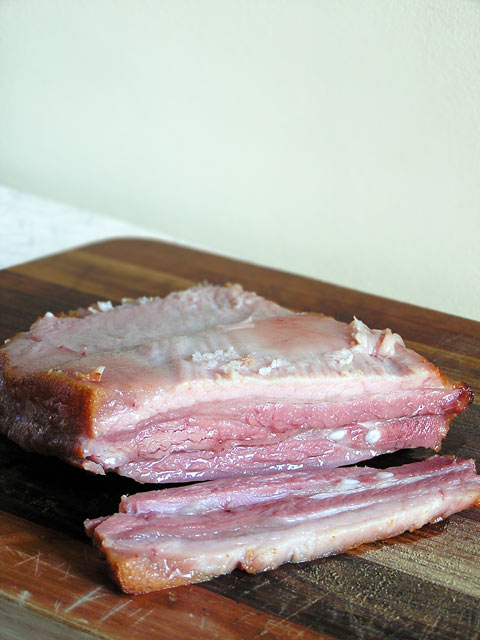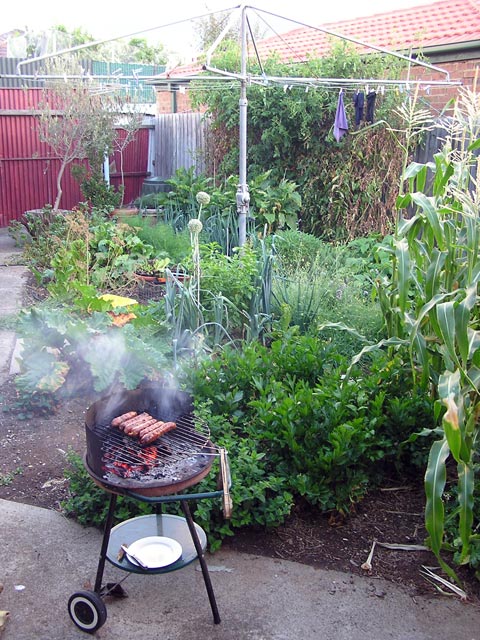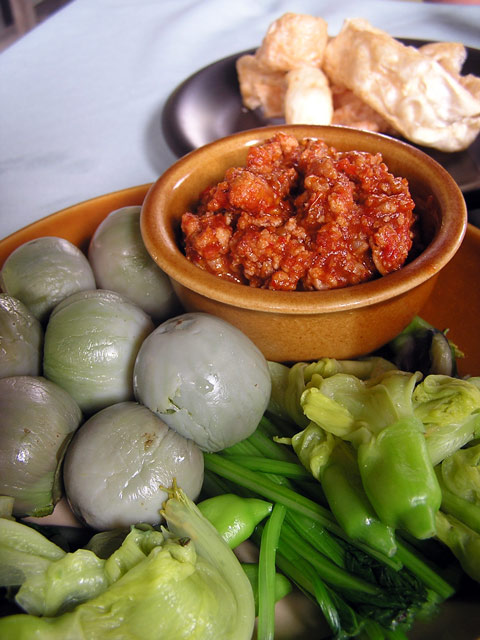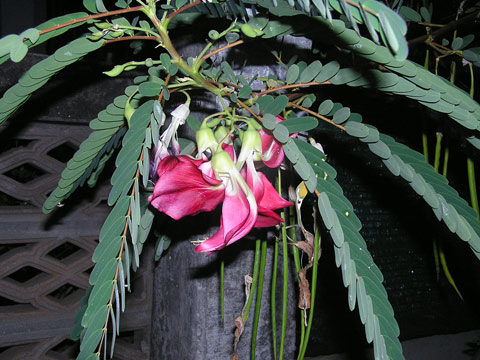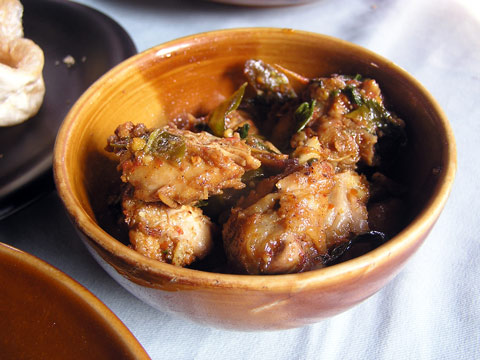Posts Tagged → pork
Your funds buy my food security.
The Jonas family grows pork that makes most other pork taste like that foamy pizza topping ham-substitute. If you’ve ever planned to cut down on how much meat you eat and then reward yourself with the best, this is it. You’ll remember where you were the first time that you ate it. Tammi Jonas is a friend, so that completely colours my view of their success and probably, the bacon.
But to paraphrase Amartya Sen, there’s no such thing as an apolitical food problem, and the problem that they’re solving agrees with my politics.
Maybe it’s me getting older, but I’ve started thinking more about food in the long term rather than day-to-day eating. Guaranteeing the future supply of the food that I want to eat is just as important as eating it in the short term. Part of that problem is how to put a relatively small amount of capital upfront to ensure that it happens. As much as I can do that at my local butchers or supermarket with what I buy in the short term, there is no transparency of supply.
So here’s a rare chance to support mine and your own food security. The Jonas’s have a crowdfunding campaign up at Pozible for a small-scale boning room and refrigeration. Funders are rewarded, quite literally, with pork.
I hope that it is the start of something much bigger.
Northern Thai in Western Melbourne: Bonus Content
Austin Bush has been hanging out with me in Melbourne over the last week and we’ve been doing the sort of thing that food bloggers do when they run into each other: drink every single pale ale made in Australia and New Zealand; eat several times a day with no regard for socially accepted “meal times”; and cook food that takes regional authenticity to ludicrous lengths which he has amply documented on his Thai food blog.
Both Austin and I are huge fans of Northern Thai food, the cuisine that skirts the Burmese border in Thailand’s northern provinces. He’s been spending plenty of time up there and myself, not nearly enough. Austin came up with a menu.
Here’s my take on it.
Sai Ua
I’d been keen to make David Thompson’s recipe for sai ua in his book Thai Food for quite some time. It’s a greasy pork sausage from Chiang Mai that is packed full of chilli, lemongrass, coriander, shredded lime leaves and hog fat. You spot it throughout Northern Thailand as a street food, chopped into bite-size chunks and served in a plastic bag. The chilli-reddened grease from it coats the inside of the bag and as a consequence, your hand.
When I came across the handful of sausage recipes in Thai Food, it did make me wonder, how many of these recipes have ever been cooked by the owners of Thompson’s tome? Chiang Mai sausage making requires an interlocking interest in regional Thai cuisine and charcuterie. In my experience, these fascinations tend to be mutually exclusive.
I’m not going to repeat the recipe here. Do David Thompson a favour and buy his book. Recipe is on page 518. My liner notes for the recipe:
- There is no need to smoke the sausage over dessicated coconut. Just grill it over an open fire. I get the feeling that Thompson added this step because it works in a commercial kitchen. If you’re cooking commercially, you can smoke the sausage in advance then finish the sausage on a flat grill because it is much quicker than the leisurely route of slow-cooking it over coals.
- More chilli. The recipe suggests 6-10 dried chillies and we used about 20. If you feel unsure about this, grind up the sausage mix with only half the chilli then fry up a test patty. We still didn’t get the color quite right – it needed to be redder. The next batch that I try will use a mix of powdered chilli and dried chillies. Otherwise the mix of herbs is spot on.
- If you’re using a commercial sausage maker, use the coarsest grind available and aim for a fat content of around 35-40%. They’re fattier than your average sausage and don’t need to bind as firmly as a western sausage. The herb mix can run straight through the meat grinder instead being pounded into a paste as Thompson suggests. The result is much closer to Austin and my recollection of Northern sausages, which have very coarse chunks of lemongrass and fine shards of lime leaf still intact.
Kaeng Hang Ley
Austin brought with him a collection of spices from Mae Hong Song, including the freshest turmeric powder I have ever smelled and the local Mae Hong Son “masala” powder, so we hit up Footscray for fresh ingredients. If you’re keen on making this particular curry, Austin has the hang ley recipe. For Thai ingredients in Melbourne, visit Nathan Thai Grocers at 9 Paisley St in Footscray. They’re amazingly well stocked with Thai goods and have a pre-prepared Hang Ley paste. At Nathan, we could find a Thai-brand sweet sticky soy and shrimp pastes just to take the dish to an extreme of regional correctness. As a coincidence, I already had Thai tamarind pulp (which is really no different from any other tamarind).
Pork belly is official local meat of Footscray. It can be found at every single butcher in the suburb, apart from the two lonely Halal meateries. I buy mine in Footscray Market because there are enough suppliers there that you can always pick out the right piece.
Saa
This recipe calls for young pea shoots and leaves, we had to settle for some slighty older and more bitter ones from Little Saigon Supermarket in Footscray. Multiple vendors had deep fried pork skin used to top this salad, but the Northern Thai-style of pork crackling which is cut into thin strips was nowhere to be seen.
Key Sources
Nathan Thai Video and Grocery, 9 Paisley St, Footscray. They’re friendly guys and even have a blog, documenting incoming Thai videos.
Little Saigon Market, 63 Nicholson Street, Footscray. Best for vegetables from across Asia. Also a good spot to pick up hard to find dried fish.
Footscray Market, 81 Hopkins St, Footscray. I only visit here for meats, mostly fish and pork.
Lung King Heen: 3 star dumplings

Scallop and prawn dumpling, Lung King Heen
It’s a strange thing to live in the bottom half of the planet that has no Michelin stars. In some ways, it has an internal logic for Michelin: the guide’s ostensible purpose was to get people out into the provinces by car and thereby burn through more Michelin rubber. Awarding stars to somewhere that can’t be accessed by automobile does not sell more French tyres. Hong Kong is one hell of a drive from France: it’s a possible but improbable journey, but the stars, they be there.
Maybe Michelin makes tyres for planes these days.
With low-cost carriers now offering flights for roughly the price of buying a beer onboard said plane, I thought that it was about time that I did some serious offshore eating and start collecting stars like a proper, credentialed food critic. Maybe it would convert me to the lifestyle of a high-end eater and my days eating delicious soup in the gutter would be over. I could credibly complain about foie gras and table linen like somebody that works for a serious but doomed print publication.
So I booked in for yum cha at Lung King Heen, Hong Kong’s only three Michelin-starred restaurant. I’m probably not making the most of the experience by eating dim sum but then again, what have I got to prove to anyone? I love dumplings. If I could take the chance at having a meal at the only Cantonese restaurant that Michelin has awarded three stars to, and have them make me a selection of dumplings I would. And did.
Critics probably like writing about serious dining because it gives you much more to write about. Filling a thousand words is easy when you eat twenty courses and you’ve got much more leeway to pick faults when you’re paying a huge bill at the end. They seated me five minutes late. The linen on the table was not perfectly flat. Service is obvious, cookie cutter silver service. English is great. The room is simple: wood panelling; huge windows frame Hong Kong’s harbour which is the “View of the Dragon” to which the restaurant’s name refers. These things are utterly meaningless when it comes to food, but maybe they’re supposed to matter to someone.
Physically, Lung King Heen’s menu has weight and silken texture. Inside, it’s much the same, classic Cantonese dishes subtly tweaked with premium ingredients and new presentation. It is a menu that plays with your memory of other Cantonese food from your past – if you don’t eat much of it, you’d never notice but if you’re an aficionado, I imagine that Lung King Heen’s head chef Chan Yan-tak is permanently winking at you from the kitchen.
There are both vegetarian and organic vegetarian options on the menu which must seem abhorrent to the average Cantonese chef, but if it’s bringing in the stars, maybe it matters. I skipped most of it for the dumplings but ordered roast suckling pig. On with the dumpling porn.
Xiao long bao come served on individual baskets; minimising the chances of puncturing the soup filled dumpling as you extract it from the steamer basket.
The roast suckling pig is presented separated; squares of rich meat topped with a square of pancake and a larger, thin pork skin hat. It’s tough to tackle with chopsticks and keep together in a single bite.
Sesame balls, unexpectedly filled with chunks of roast goose. Scallop dumplings have two whole scallops in them; spring rolls with sea whelk crispness on the outside and gooey interior with chunks of whelk that taste like the fresh sea. The pastry on the beef and morel dumplings tasted like unadulterated butter.
About ten dumplings in, the whole experience reminded me of Maytel from Gut Feeling’s assessment of Thomas Keller’s food:
I know that if I was to put an oyster with a big dolllop of caviar and cover it all in a butter sauce people would probably applaud me too
Top end dining seems to be caught in a self perpetuating cycle – you get lauded by Michelin, you ramp up the use of premium ingredients, you get lauded further. Lung King Heen’s use of luxury ingredients is still restrained and judicious amongst the dumpling menu but it could go awry very quickly.
Does Hong Kong need Michelin’s external validation? The locals already know that they’re onto a good thing and somehow quantifying that experience into a range of zero through three stars seems to do it a grand disservice. I’ve always found anonymous food reviewing somehow dishonest. We all bring our prejudices to the table and stating those prejudices brings out the best in critics; even if that prejudice is unadulterated dumpling love. I’m not looking forward to Michelin stepping south of the equator. We have our own laughable hat system.
Price: ~HK$400 a head
Location: Four Seasons Hotel, Fourth Floor, 8 Finance Street, Central, Hong Kong
Telephone. (852) 3196-8888
Parachute Foodblogging 2: Restoran Nasi Kandar KL
Kuala Lumpur is the perfect town for stopover eating: parachuting into town for the few hours between flights. I’ve done it once before but this time was a bit more of a nostalgia trip. For me, breakfast in KL is synonymous with nasi kandar; Malaysian Tamil Muslim food from a cheap restaurant, leaden curries matched with feather-light roti.
Restoran Nasi Kandar KL on Jalan Tun Tan Cheng Lock, just around the corner from Petaling Street is by no means the greatest nasi kandar in town, but it feels like my nasi kandar. The grime-streaked yellow facade seems unchanged and the Indian Malaysian guy at the front counter still seems overwhelmingly pleased to see me. It was just between the cheap backpacker joint where I spent the most of my time in Malaysia and Pasar Seni station. The obvious place to stop on the way to eat somewhere else every day. They do an excellent roti canai: the accompanying curry is passable but the roti is spot on: buttery, both fluffy and elastic. It’s some of the best eating in transit that can be done.
Just in case roti is not enough, there is a decent kopitiam across the road with the usual jumble of vendors: a roast meat guy, various noodle soups and fried noodles stands that encircle a coffee shop. I hit up the pork and rice just in preparation for Cambodia.
Fatty rice but dry pork. I should have had that third roti.
Making Bacon
There is a descent into a darker realm when you begin cooking with a product labelled “CAUTION: Do not swallow”. The possibility of inadvertently killing your loved ones rises and your ability to rely on the way that a preparation tastes before cooking declines. The normal sensory cues that stop most sane people eating food that is deadly can no longer be relied upon. Things must be measured rather than guessed.
Sodium nitrite, the key to this particular charcuterie abyss, alone is not for human consumption. At least it says as much on the bag. But with it and a little pork belly, salt and sugar, you can free yourself from the hegemony of industrial bacon.
The Basic Bacon Cure
(from Ruhlman and Polcyn’s Charcuterie):
450gms of salt
225gms of sugar
50gms of pink salt (6.25% sodium nitrite; marketed as TCM, Instacure #1)
Method: Mix together thoroughly.
Buy one to two kilos of good pork belly. Lay about 50 grams of the cure onto a surface large enough for your piece of belly. Press all sides of the belly into the cure until it is covered with cure. Bag it into a zip-lock baggie, tag it with the date then refrigerate it for a week turning over every day.
The wait is over. The belly firms up a little.
Wash the cure and pork juice from the belly, pat dry, then roast for two hours at 100 degrees Celcius, by which time your house will smell like what I imagine the Sirens would have smelled like to the Argonauts, if Jason had have been in search of the Golden Ham. If it wasn’t nigh on impossible to buy a real American smoker in Australia, this stage would have been supplanted by a few hours over hickory smoke in the backyard. Damn Australian barbecue parochialism.
Slice off the rind and eat it.
Apart from the possibility that my arteries would clog shut in mid-bite, I couldn’t think of any reason not to crunch away on it. Plus I have a congenital inability to discard anything that is remotely edible. The fact that it is crunchy and bubbling in the first place suggests that my oven is running much hotter than 100 degrees, so I may as well reap the only rewards of a faulty thermostat.
Slice and fry to your heart’s continued malcontent. Your own bacon will be richer, juicier and thicker. More fat renders from it when cooked. It is texturally more dense and chewier than your store-bought fare. You’ll wonder how you were ever hoodwinked into buying the facsimile of bacon available in most stores and what other sad cuts of pork have been foisted upon you in the past.
Sausage Fancier
Once you’ve seen how sausages are made, you’ll want to eat nothing but sausages. This was my first impression of home sausage making; my second was that making sausages is possibly my true calling and that my university loan debts could have been better spent on a meat mincer and practicing the barbecuing arts rather than on undergraduate degrees.
I started with a setup familiar to all new converts to the testaments of sausage making: a copy of Michael Ruhlman and Brian Polcyn’s Charcuterie and George Foreman’s Lean Mean Meat Mincing Machine. That George Foreman lends his moniker to an electric meat mincer is no great surprise to me. I discovered years ago that Foreman had made not less than nine billion American dollars from selling a multitude of appliances in no way limited to the indoor grill. The hypocrisy of adding the word “Lean” to a product that should be pumping out sausages that should be about 25% fat is not lost in me.
If you’re looking to lose weight, eating pork fat stuffed into a tube is not your best option. I’m sure that George would argue that his Lean Mean Meat Mincing Machine means that the home sausage fancier could control the fat content in their sausages just like he himself took control of his 1971 battle with Joe Frazier in Kingston, Jamaica, but I’d rather be eating richer, fattier sausages in moderation than the fat-free simulacra of a sausage. Fat is vital for human survival, just like the footwork Foreman displayed in his 1987 fight with Steve Zouski.
My first batch was perfect. I followed Ruhlman’s basic garlic sausage recipe and added a tablespoon of roughly crushed cumin seeds, chilli flakes, Kampot pepper, then lowered the salt content. The Lean Mean Meat Mincing Machine shudders away. I achieved the “primary bind” that Ruhlman mentions; once ground, the meat turns sticky as the protein breaks down. The casein skin burst only once while stuffing.
I grilled the sausages over charcoal as slowly as possible. I ate them with friends in absolute stunned silence.
I’ve begun eyeing off the greying cut-price meats in the supermarket refrigerators with a single question in mind: will it mince? What else can I stuff? What memories of sausages past can I recapture? How much of my life has been wasted not making my own sausages?
If there is one thing you can expect from this blog in the coming years, it is more sausage.
My basic garlic, cumin and pepper sausage recipe
(based on Michael Ruhlman and Brian Polcyn’s “Fresh Sausage Master Recipe: Fresh Garlic Sausage”)
Yields: about two and a half kilograms of sausages.
The original Ruhlman/Polcyn recipe calls for 3 tablespoons of salt. I ground in two tablespoons of this and fried up a patty of the mince to test the flavour before stuffing the casings. For me, it was salty enough but add more or less to your taste. Real intestine casings are tough to find in Australia. I went with casein.
Ingredients:
1 tablespoon of cumin seeds, coarsely ground
1 teaspoon of dried chilli flakes
1 tablespoon of Kampot pepper (or the best quality black pepper you can get), coarsely ground.
2 tablespoons of the cheapest salt available*.
3 tablespoons of minced garlic
2 cups of white wine
2.5 kilograms of fatty pork meat (approx 25% fat. I used 2 kilos of shoulder to 0.5 kilo of belly)
Method:
Pound the cumin, pepper and chilli flakes in a mortar and pestle until most of the cumin seeds are broken. Finely chop the garlic. Chop the meat into pieces small enough to fit into your mincer. Mix meat, spices and salt together in a bowl and refrigerate for at least two hours.
Soak casein casings in one cup of white wine.
Mince all ingredients into a bowl set in ice, on the fine (0.25cm) grade. Add one cup of wine and mix the mince until it becomes sticky. Fry up a patty of meat to test flavouring, then adjust anything to taste.
Change mincer to stuffer attachments. Thread about a metre of casings over attachment and tie the end in a knot. Pour mince into mincer and stuff away!
Section the giant sausage into odd lengths by twisting the casings – it is much easier to make one metre-long sausage and do this at the end of the process rather than juggling the sausage and the mincer. Charcuterie has a twee picture of measuring a sausage with a ruler as to ensure uniform size; my approach is less anal but equally obscene. Cook over a fire, as slowly as you can bear.
For a much more pictorial recipe, buy Ruhlman and Polcyn’s Charcuterie: The Craft of Salting, Smoking, and Curing.
* – Expensive salt makes no difference when dissolved in food, especially in sausages such as these which are packed with other aromatic components. Jeffrey Steingarten tests this out in It Must Have Been Something I Ate.
The road to Mae Hong Son

Night market in front of wat at Maehongson
The road to Mae Hong Son in Northwest Thailand is dream trip for motorcyclists. A road of endless switchbacks, freshly paved, glides you through hidden valleys filled with stepped rice paddies, small farms, streams revealing waterfalls, hidden caves and palaces abandoned until the next warm season drives royalty into the highlands. Bamboo arches over the road in the lower reaches of the hills to be replaced by stark pine forest as you snake your way up the summits.
The road runs close enough to Burma for bored Thai military police to be stationed every few kilometres checking for contraband or smuggled people but unconcerned with Westerners on motorbikes. Lookout points stare over the mountain ranges. By all rights there should be no great reward at the end so as to prove a cliché about the intrinsic nature of journeys and destinations. But there is and it’s Baan Phleng Restaurant.
If there is one thing that I’ve learnt about dining in Southeast Asia, it is to avoid any restaurant with the words “authentic”, “local”, or “traditional” plastered out the front in English. It is the sign that the restaurant embodies none of those things and most often personifies the opposite. In this case, I was wrong. Contained within the ornate temple-cabinet were five or six dishes, only one of which was entirely familiar, the rest were surprises.
The great thing about an average firm tofu is that it carries fat and meat flavours so well and thus is wasted on vegetarians. Fatty and chilli-hot carnivore tofu.
I’d spotted bundled, spiralling fronds of ferns at the northern Thai markets in Pai, Chiang Mai and Mae Hong Son itself, but resigned myself to not being able to find it on a restaurant menu because I couldn’t find the Thai word for it and was too embarrassed to phone a friend for translation help. I’d mentally consigned it to that group of foods that I believe, rightly or otherwise, only get cooked at home and never see the light of day on a restaurant menu in one of the languages that I can read. Despite the large amount of sesame seeds and deep fried garlic mixed through, the above fronds had a nutty flavour all of their own.
Nam prik, a tub of ground pork as hot as freshly-dropped napalm, accompanied by eggplant and flowers. Any botanical help on the steamed flowers served alongside the pork would be much appreciated. I snapped what I think is the flower on the plant from which it came, but can’t be sure.
As an ingredient, they might make for a workable local substitute for zucchini or pumpkin flowers, although much more fragile and slightly bitter.
Gaeng Kai Mae Hong Son – Chicken curry with lime leaves aplenty and a few local herbs that I can’t readily identify.
Location: Baan Phleng Restaurant, on Khunlumpraphat St, Mae Hong Son
Getting there: Hire a motorbike from Chiang Mai, ride at a leisurely pace out to Pai on day one, Soppong on day two and then onto Mae Hong Son on day three. Repeat in reverse, or complete the “Mae Hong Son loop” through Mae Chaem and then back to Chiang Mai. GT-riders.com sells an excellent map.
Or just catch the bus.
Note: Map link points to Baan Phleng restaurant.
